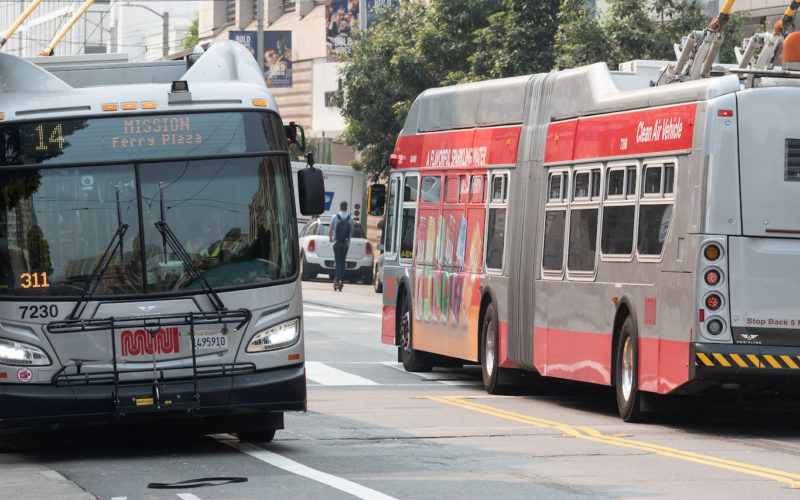
At last week’s Innovations in Mobility Public Policy Summit in Washington, the contrast between city leaders and federal interests couldn’t be clearer. Panelists from cities and local transit agencies, like Luann Hamilton of Chicago’s Department of Transportation and Tim Papandreou of the San Francisco Muni talked about how they’re embracing bikesharing and car-sharing, or untangling the thorny regulatory issues around on-demand taxis. Meanwhile, a panelist from the Federal Highway Administration discussed a handful of projects funded by the Bush-era Value Pricing Pilot Program, whose funding was eliminated by Congress two years ago.
It’s not that USDOT is divorced from or unaware of new forms of technology-enabled mobility. The department recently honored the developers of multimodal transportation app Ridescout. And FHWA has worked with UC-Berkeley’s Susan Shaheen to study dynamic ridesharing. But city officials are clearly the ones on the front lines when it comes to shared-use mobility issues.
Keynote speaker Peter Torrellas, a vice president at Optym, called for an alignment of federal, state, and local funding and policy to support shared-use mobility and the development of a different kind of “muscle” to make things happen in mobility. By contrast, Summit panelists who worked with or for Congress talked mostly about the looming bankruptcy of the federal Highway Trust Fund, and the years-long process to finalize MAP-21′s performance measures. Washington did not look poised to drive a revolution in shared-use mobility — but it could do much more to allow local innovation to thrive.
One way to encourage local innovation is through competitive grant programs, as evidenced by the TIGER program. These programs can bring the best out of cities and regions, rewarding innovative, multimodal projects. But the most recent federal transportation law, MAP-21, took national policy in exactly the opposite direction. Competitive “discretionary” programs were slashed, and their money rolled into the larger “formula” programs that dole out money to state departments of transportation. These formula programs were also tweaked to focus on the interstates and other large roads. Finally, although some formula dollars had been traditionally reserved for regional Metropolitan Planning Organizations, those set-asides (“suballocations”) were pared back, giving states even greater control over federal funds than in the past.
That leaves cities at the mercy of state transportation departments, which often prioritize state highways and spread their funds around to appease the lawmakers who oversee them. Local leaders are now speaking out, trying to win support for bills that would reverse this unwelcome trend and create competitive, locally oriented grant programs in every state.
Aligning timescales, by making the federal grant process less cumbersome, might be another necessary set of reforms. SF Muni’s Papandreou noted that innovation in the private sector takes place over days, while an “innovative project” within city government can take months. Meanwhile, years can pass between applying for a federal grant and being awarded the funds due to the requirements involved, another year can pass until those funds are obligated, and it takes still longer before an awardee sees a dollar of federal money since the feds often do not provide money up front but reimburse costs at the end of a project.
Congressman Earl Blumenauer kicked off last week’s Summit with a reminder that changes to federal transportation law can have wide-ranging impacts on the ground. In 1991, new flexibility in the law allowed states to spend significant amounts of what had been highway-dedicated dollars on transit, biking, and walking. This unleashed investment in multimodal projects across the country, and remains a cornerstone of federal law. The changes needed now may not be new silos of funding, but a federal process which is closer to the speed of innovation, and which rewards those cities that are doing the hard work of integrating shared-use mobility into their transportation networks.
 On the Brink: Will WMATA’s Progress Be Erased by 2024?
On the Brink: Will WMATA’s Progress Be Erased by 2024?
The experience of being a WMATA rider has substantially improved over the last 18 months, thanks to changes the agency has made like adding off-peak service and simplifying fares. Things are about to get even better with the launch of all-door boarding later this fall, overnight bus service on some lines starting in December, and an ambitious plan to redesign the Metrobus network. But all of this could go away by July 1, 2024.
Read More What’s Going on With Transit Service at the Seven Highest Ridership U.S. Cities? SF Edition
What’s Going on With Transit Service at the Seven Highest Ridership U.S. Cities? SF Edition
As of March 2022, SFMTA was operating 88% of pre-pandemic service and added back even more service in July.
Read More